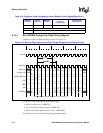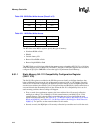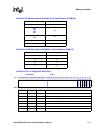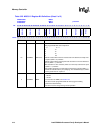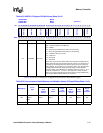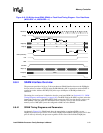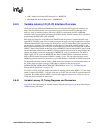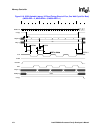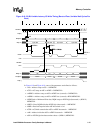
6-48 Intel® PXA26x Processor Family Developer’s Manual
Memory Controller
6.8.3 ROM Interface
The processor provides programmable timing for both burst and non-burst ROMs. The RDF field
in MSCx is the latency (in memory clock cycles) for the first, and all subsequent, data beats from
non-burst ROMs, and the first data beat from a burst ROM. RDN is the latency for the burst data
beats after the first for burst ROMs. RRR delays the following access to a different memory space
to allow time for the current ROM to three-state the data bus.
RRR must be programmed with the maximum t
OFF
value, as specified by the ROM manufacturer.
For hardware reset initialization values, refer to Section 6.9, “16-Bit PC Card/Compact Flash
Interface” on page 6-57. MSC0[15:0] is selected when the address space corresponding to nCS0 is
accessed. The processor supports a ROM burst size of 1, 4, or 8 by configuring the MSCx[RTx]
register bits to 0, 2 or 3 respectfully.
6.8.3.1 ROM Timing Diagrams and Parameters
The timings for burst and non-burst ROMs are shown in Figure 6-14, Figure 6-15, and Figure 6-16.
010
Burst-of-4
ROM or Flash
(non- burst writes)
RDF+1
(0,4)
RDN+1
(1:3,5:7)
RDF+1
(0,4)
RDN+1
(1:3,5:7)
0 N/A RDF+1 N/A
011
Burst-of-8
ROM or Flash
(non-burst writes)
RDF+1
(0)
RDN+1
(1:7)
RDF+1
(0)
RDN+1
(1:7)
0 N/A RDF+1 N/A
100
Variable
Latency I/O
RDF+
RDN+2+waits
RDF+1+
waits
RDN+1
RDF+
RDN+2+waits
RDF+1+
waits
RDN+1
Table 6-26. Asynchronous Static Memory and Variable Latency I/O Capabilities (Sheet 2 of 2)
MSCx[RTx]
Device
Type
Timing (Memory Clocks)
Burst
Read
Address
Assert
nOE
Assert
Burst
nOE
Deassert
Burst
Write
Address
Assert
nWE
Assert
Burst
nWE
Deassert



